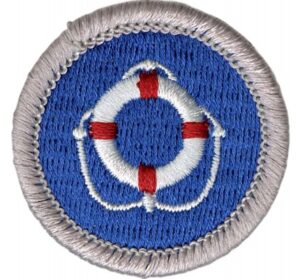The Lifesaving merit badge teaches one of the most vital skills in Scouting—how to respond confidently and safely in a water emergency. Unlike the Swimming merit badge, which focuses on personal fitness and aquatic comfort, Lifesaving prepares you to assist others in danger, equipping you with judgment, strength, and the techniques needed to act responsibly under pressure.
As one of the Eagle-required badges, Lifesaving is a major milestone on your Scouting journey. It requires strong swimming ability, calm decision-making, and plenty of practice—but it also offers one of the most rewarding learning experiences in Scouting.
Timeframe / Difficulty
The Lifesaving merit badge is one of the more advanced Eagle-required badges, both physically and mentally. Scouts must be strong swimmers and comfortable in deep water before beginning the rescue requirements.
If you’ve already completed the Swimming merit badge, you’ll have a great foundation. Most Scouts complete Lifesaving in 3–4 weeks if they have regular access to a pool or lake, and the badge is commonly offered at summer camp aquatics programs.
This badge is considered moderate to difficult depending on your swimming confidence and your access to supervised water training.
Tips for Success
1. Don’t skip physical preparation.
You’ll need strong swimming technique, stamina, and the ability to tow another person. Train in advance with distance swims and underwater dives.
2. Practice communication.
Many rescues require you to talk clearly and calmly to the victim. Rehearse what you’ll say during each type of approach.
3. Understand the rescue order: Reach, Throw, Row, Go.
Only enter the water when other options aren’t possible—and always prioritize your own safety.
Complete Guide to the Lifesaving Merit Badge
This guide is only intended as a starting point for your research. Directly copying the information offered here is plagiarism. Doing your own research will allow you to get the most out of this badge and maintain the 12 points of the scout law. A scout is trustworthy!
Below is a breakdown of every current requirement for the Lifesaving merit badge, followed by guidance and tips for each one.
Requirement 1
1. Before doing requirements 3 through 15, review with your counselor the principles of Safe Swim Defense.
Tips:
- Be able to explain all eight principles of the BSA Safe Swim Defense plan and how each one contributes to a safe swimming environment.
- This is the foundation of water safety in Scouting—don’t skip it.
Requirement 2
2. Before doing requirements 3 through 15:
(a) Earn the Swimming merit badge.
(b) Swim continuously for 400 yards using each of the following strokes in a strong manner, in good form with rhythmic breathing, for at least 50 continuous yards:
- Front crawl
- Sidestroke
- Breaststroke
- Elementary backstroke
Tips:
- Most Scouts complete this badge after Swimming, which builds the required strength and technique.
- Practice endurance swimming to complete all 400 yards without fatigue.
- Use a lap pool for even pacing and track your yardage carefully.
Requirement 3
3. Explain the following:
(a) Common drowning situations and how to prevent them.
(b) How to identify persons in the water who need assistance.
(c) The order of methods in water rescue.
(d) How rescue techniques vary depending on the setting and the condition of the person needing assistance.
(e) Situations for which in-water rescues should not be undertaken.
Tips:
- Know the signs of a distressed swimmer—they may not be shouting or waving.
- Explain the rescue order: Reach, Throw, Row, Go—and when not to attempt a rescue.
- Always assess water conditions, victim behavior, and available gear before entering the water.
Requirement 4
4. Demonstrate “reaching” rescues using various items such as arm, leg, towels, shirts, paddles, poles.
Tips:
- Practice extending items safely while lying down to avoid being pulled in.
- Emphasize maintaining communication with the victim.
Requirement 5
5. Demonstrate “throwing” rescues using various items such as a line, ring buoy, rescue bag, and free-floating support. Successfully place at least one such aid within reach of a practice victim 25 feet from shore.
Tips:
- Learn how to properly coil and throw a rope.
- Accuracy is essential—aim for just beyond the victim so they can grab it.
Requirement 6
6. With your counselor’s approval, view in-person or on video a rowing rescue performed using a rowboat, canoe, kayak, or stand-up paddleboard. Discuss with your counselor how effectively and efficiently the rescue was performed.
Tips:
- Watch rescue demos on YouTube or during summer camp aquatics training.
- Focus on how the rescuer approaches, stays balanced, and assists the victim safely.
Requirement 7
7. List various items that can be used as aids in a “go” rescue. Explain why buoyant aids are preferred.
Tips:
- Buoyant aids include life rings, rescue tubes, boards, and kickboards.
- They keep both rescuer and victim afloat and reduce physical strain.
Requirement 8
8. Correctly demonstrate rescues of a conscious practice subject 30 feet from shore in deep water using two types of buoyant aids provided by your counselor. Use a proper entry and a strong approach stroke. Speak to the subject to determine his or her condition and to provide instructions and encouragement.
(a) Present one aid to a subject, release it, and swim at a safe distance as the subject moves to safety.
(b) In a separate rescue, present the other aid to a subject and use it to tow the subject to safety.
Tips:
- Speak calmly to the victim, and do not make contact unless necessary.
- The first rescue emphasizes safe delivery; the second requires physical towing.
Requirement 9
9. Discuss with your counselor when it is appropriate to remove heavy clothing before attempting a swimming rescue. Remove street clothes in 20 seconds or less, enter the water, and approach a conscious practice subject 30 feet from shore in deep water. Speak to the subject and use a nonbuoyant aid, such as a shirt or towel, to tow the subject to safety.
Tips:
- Practice removing outer clothing efficiently.
- A shirt or towel can act as a safe tether and tow line in emergencies.
Requirement 10
10. Discuss with your counselor the importance of avoiding contact with an active subject and demonstrate lead-and-wait techniques.
Tips:
- Stay out of reach of panicked victims.
- Lead-and-wait involves tossing an aid and backing off while encouraging the victim to help themselves.
Requirement 11
11. Perform the following nonequipment rescues for a conscious practice subject 30 feet from shore. Begin in the water from a position near the subject. Speak to the subject to determine his or her condition and to provide instructions and encouragement.
(a) Perform an armpit tow for a calm, responsive, tired swimmer resting with a back float.
(b) Perform a cross-chest carry for an exhausted, responsive subject treading water.
Tips:
- These rescues require physical strength and technique—practice in a supervised setting.
- Focus on proper body positioning and maintaining the airway above water.
Requirement 12
12. In deep water, show how to escape from a victim’s grasp on your wrist. Repeat for front and rear holds about the head and shoulders.
Tips:
- Practice calmly breaking holds without panicking.
- Use leverage and twisting motions to escape safely.
Requirement 13
13. Perform the following rescues for an unconscious practice subject at or near the surface 30 feet from shore. Use a proper entry and strong approach stroke. Speak to the subject and splash water on the subject to determine his or her condition before making contact. Quickly remove the victim from the water, with assistance if needed, and position for CPR.
(a) Perform an equipment assist using a buoyant aid.
(b) Perform a front approach and wrist tow.
(c) Perform a rear approach and armpit tow.
Tips:
- Always assume a spinal injury until proven otherwise.
- Support the head and neck while moving the victim.
- Practice these with trained supervision.
Requirement 14
14. Discuss with your counselor how to respond if a victim submerges before being reached by a rescuer, and do the following:
(a) Recover a 10-pound weight in 8 to 10 feet of water using a feetfirst surface dive.
(b) Repeat using a headfirst surface dive.
Tips:
- Equalize pressure when diving deep.
- Build lung capacity through breath control drills before attempting this.
Requirement 15
15. Demonstrate management of a spinal injury to your counselor:
(a) Discuss the causes, signs, and symptoms of a spinal injury.
(b) Support a faceup subject in calm water of standing depth.
(c) Turn a subject from a facedown to a faceup position in water of standing depth while maintaining support.
Tips:
- Always stabilize the head and neck.
- The head splint technique is commonly used—ask your counselor to demonstrate.
Requirement 16
16. Demonstrate knowledge of resuscitation procedure:
(a) Describe how to recognize the need for rescue breathing and CPR.
(b) Demonstrate CPR knowledge and skills, including rescue breathing, on a mannequin under the guidance of a current CPR/AED instructor trained by a nationally certified provider.
Tips:
- Take a certified CPR/AED course through the Red Cross, American Heart Association, or your local EMS.
- Practice regularly to keep your skills sharp.
Requirement 17
17. With your counselor, discuss causes, prevention, and treatment of other injuries or illnesses that could occur while swimming or boating, including hypothermia, dehydration, heat-related illnesses, muscle cramps, sunburn, stings, and hyperventilation.
Tips:
- Many of these topics overlap with the First Aid merit badge.
- Know both the symptoms and the first aid responses.
Conclusion
The Lifesaving merit badge challenges Scouts to act with courage, strength, and intelligence during water emergencies. You’ll come away not only with advanced swimming skills, but with the confidence to protect others when it matters most. Whether earned at camp or with your troop, this badge is a true mark of preparedness.
Be sure to check out our other Eagle-required badge guides:
You can view the official Lifesaving merit badge requirements on Scouting.org.
Stay sharp, stay safe—and always be prepared.





